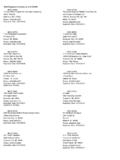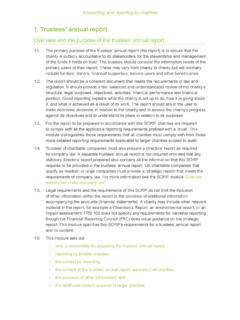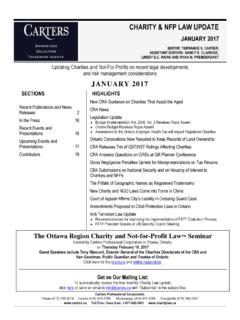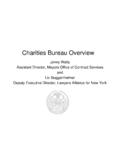Transcription of ILM Approved Factsheet on Section 117 Charities …
1 ILM Approved Factsheet on Section 117 Charities Act 2011 August 2012 Prepared for ILM by Henmans LLP Introduction Section 117 Charities Act 2011 (previously s36 Charities Act 1993) was enacted in order to ensure that Charities are dealing properly with the disposition of real property in which they have an interest. Unfortunately, a number of confusing issues have arisen where land is bequeathed to Charities by Will. This Factsheet attempts to clarify some of the areas most commonly encountered by legacy officers and PR's. It has been settled by Christopher McCall QC on the basis of his Opinion, which may be appended to this Factsheet . This Factsheet was updated by Henmans LLP in August 2012 to recognise consolidating legislative changes introduced in the Charities Act 2011 .
2 S117 will have to be complied with when land held by or in trust for a charity is sold, leased or otherwise disposed of. It is important to note that: S117 only applies to land in England and Wales; S117 does not apply to exempt Charities ; S117 does apply to unregistered Charities ; S117 does apply to Charities based outside England and Wales if they are registered in England and Wales. The single most important aspect to consider in relation to s117 is who has the power of sale of land. You will find attached a flow-chart to assist in deciding whether s117 applies and if so, who is responsible for compliance. Main principles If land is disposed of by the PR's during the administration of an estate as part of the ordinary administration process the land is not charity land and s117 will not need to be complied with.
3 This applies even if a charity is acting as personal representative. By contrast, where an appropriation has taken place, the PR's have no further power of sale other than at the instruction of the entitled beneficiary. If that beneficiary is a single charity, s117 applies and the charity's Trustees must comply. [If several Charities benefit, the trustees of the land who hold for the benefiting Charities must comply and it is not necessary for each benefiting charity to gain a separate report - see The Report below.] Tax issues The PR's must pay Capital Gains Tax from the estate on any gain above their annual allowance, regardless of the tax status of the beneficiaries. Appropriation is a procedure recognised by the Inland Revenue for transferring the beneficial interest to the beneficiary or beneficiaries without relinquishing the legal title.
4 Appropriation thus enables sale of property to take place on behalf of charitable organisations, utilising their exemption from Capital Gains Tax. The decision whether to make an appropriation is for the PR s; where there are mixed beneficiaries they must satisfy themselves that it is right to appropriate to one class and not to the other, for instance on tax grounds. There will be other circumstances where appropriation is not suitable, such as where valuations present special problems. In tax terms an appropriation may be particularly undesirable: ILM Approved Factsheet on Section 117 Charities Act 2011 August 2012 When the gain is below the PR's CGT allowance; When the property is not likely to gain at all; Where the beneficial interest in a property is shared between Charities and individuals and appropriation might penalise the individuals' tax position - the PR s have a duty to balance the interests of beneficiaries.
5 In general, appropriations will be hard to justify where there would be an unjust balance of advantage or disadvantage to any one or more of the beneficiaries. It is thus for the charitable beneficiaries in any given case to consider whether they wish to request an appropriation and for the PR s to consider whether it is right to make one weighing up the benefits and costs. The final decision lies formally with the PR s. One charity or several? Where a single charity is the beneficiary of the interest in land, and there has been an appropriation, Trusteeship of the land for s117 purposes automatically transfers from the PR s to the charity's Trustees, who then have power of sale even though the legal title stays with the PR s; the PR s must do with the land what the charity tells them.
6 Where there are two or more Charities , the power of sale will remain with the PR s or nominated Trustees if not the PR s themselves. They are therefore the charity trustees for the purposes of s117 and not the trustees of the individual Charities . Specific situations where s117 applies S117 will need to be complied with in the following circumstances: The land is, prior to entry into an agreement to effect a disposition of that land, appropriated by the personal representatives wholly to a charitable institution (the charity's Trustees must comply) or wholly between two or more charitable institutions (the PR s must comply); The land is held in a trust of land, the life tenant of which has died, and the remainderman is a charitable institution (the charity's Trustees must comply) or the remaindermen are all charitable institutions (the Will Trust Trustees must comply); Land has been assented to the charity.
7 [NB Section 117 will apply to any sale by a charity of its own interest in a trust of land even if other interests are owned by non- Charities . For instance, if a charity owns a share in a property and decides to sell that share in the land (whoever owns the other shares) then s117 applies to the sale of the share as it is an interest in land held by or in trust for a charity: however if the whole of the land is sold by the trustees of the land, s117 will only apply to those trustees (alone) where all the interests in land are held for charity.] Specific situations where S117 will not apply Wherever there is a mix of Charities and non- Charities , s117 will not apply. That is, where co-beneficiaries of the interest in land are private individuals or exempt Charities or a non-charitable trust such as a life tenant who is also a beneficiary.
8 Thus s117 will not apply where: Appropriation has the effect of creating a trust of land in which some of the beneficiaries are not Charities ; Land is held in a trust of land and is sold during the life of the life tenant even though the remainderman is a charitable institution; On the death of the life tenant, the remaindermen are not all Charities . ILM Approved Factsheet on Section 117 Charities Act 2011 August 2012 Complying with s117 In order for a charity to effect a disposition of land, an order of the Court or the Charity Commissioners is required. However, s117 allows charitable trustees to sell land without such an order as long as the following requirements are complied with: The disposition is not to a connected person; The disposition is preceded by an agreement to effect the disposition; Before entering into such an agreement, the trustees comply with the procedure set out in s119(1) or, as the case may be, s120(2).
9 This will involve obtaining advice from a suitably qualified person on the merits of the proposed disposition. A Connected Person The restrictions on disposition to a connected person apply to someone who, in relation to the charitable trust of land (if there has been no assent) or to the recipient charity (if there has been), is within s118, s350, s351 and s352 to the Charities Act 2011 . It includes: A charity trustee or trustee for the charity; The donor of any land to the charity (whether the gift was made on or after the establishment of the charity); A child, parent, grandchild, grandparent, brother or sister of any such trustee or donor; An officer, agent or employee of the charity; The spouse of any of the above people.
10 The date of the disposition is the relevant date for determining whether the connections exists, not the date of the agreement to effect the disposition. If the person is a connected person an order sanctioning the disposition must be obtained from the Charity Commission. A difficulty can arise with sales at auction since it will not be known until the fall of the hammer whether the purchaser is a connected person or not. In this case, the Charity Commission advise that the sale particulars should state that, if the purchaser of the land turns out to be a connected person, the sale will be conditional upon the sanction of the Charity Commission being obtained. The Report under s117 It is normally necessary for the Trustees, before entering into an agreement to effect a disposition of charity land, to obtain and consider a written report on the proposed disposition from a qualified surveyor acting exclusively for the charity.








